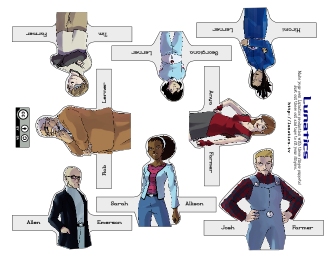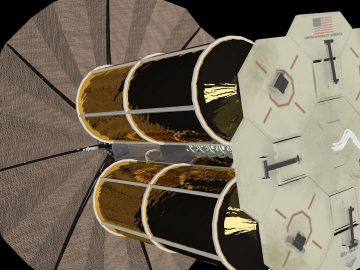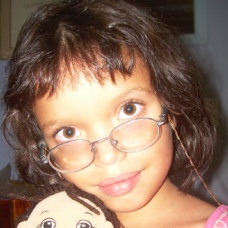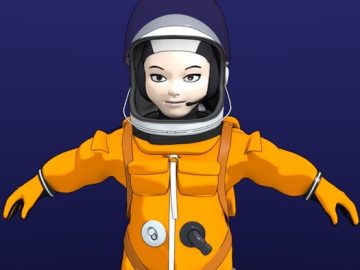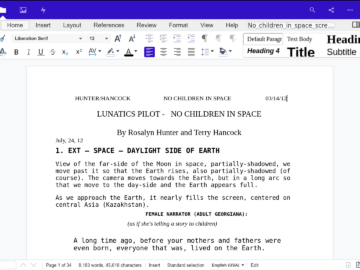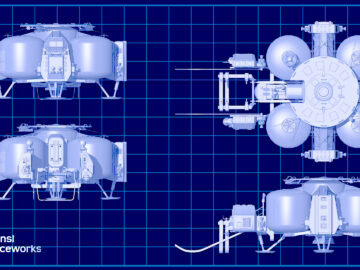Author: Terry Hancock
We have a great voice cast on “Lunatics!” which is one reason I really, really want to see this finished. One of the first characters introduced is “Hiromi Lerner”, voiced by Karrie Shirou. The part of Hiromi Lerner is tricky. She’s a subtle character — it’d be really easy for her to come off as a stereotypical homemaker role and thus dismissed, but the thing is, she’s somebody who’s decided to do this role on the Moon . Inside, Hiromi is like iron, and you could argue that she’s the one that really holds that colony together.
We really need some help getting the word out about our Kickstarter campaign, and one of our fans suggested neat idea: if you embed our Kickstarter widget on your webpage until Aug 20th, we’ll send you a free, high-quality printed set of OFFICIAL finger puppets and a signed thank you note. Details after the fold…
Over the course of 2012, we had a total of over 30 people work on Lunatics! But there was still a lot to do in 2013. We got a huge boost from mechanical modeler Chris Kuhn joining the team this Summer: Lead Mech Modeler: Chris Kuhn
We’ve cut a new trailer for the pilot episode project, in response to fan feedback. This one is much shorter and more energetic — hopefully catchier. We’ve also revised the Kickstarter video to start with this 6-second teaser. The old trailer/teaser/demo/short is still available on YouTube and Vimeo, of course.
I was invited to this event to discuss three projects currently crowd-funding, our own “Lunatics!” project, another film project called “Algorithm” , and the huge (and controversial) Ubuntu Edge project (which is aiming to raise $32 million to build a limited run of smartphones running the “Ubuntu Touch” operating system — that’s over 750 times as much as we need for “Lunatics!”). This was a fun chat — the part about “Lunatics!” is mostly towards the end:
Ariel Hancock (who plays “Georgiana Lerner” in “Lunatics!”) asks for your support:
We’ve sent out some press releases for the Kickstarter. I’ve also posted an update about the non-photorealisti visual style and how we hope to render our characters in the final production (or at least what some of our options are).
There are several factors we have to balance in coming up with a style of animation and rendering for “Lunatics!” You might think that 3D animators should always try for maximum realism (“photorealism”) when making animation, but this is not necessarily a good idea. First of all, the human eye is extremely good at spotting errors in photorealistic renderings and especially in animation. This is the basis of the problem known as the “uncanny valley effect”: if you have extremely photo-accurate models and renderings of characters, then even the slightest error in movement creates a disturbing “creepy” effect. Such animations are often described as “zombie-like” or “doll-like”. This is because we are very sensitive to tiny differences in the way real people move.
Well, I’m not sure what’s happening with our Kickstarter. We’re stuck at 3% with 22 backers. I don’t know i that’s because I’ve overestimated how many people are supporting us or if it’s because you’re disappointed with the results. Could even be I’m just talking to myself and a bunch of web crawlers here, and only imagine that anyone is following this. It could be that even our closer followers aren’t seeing all of these posts, with all the changes that have been happening in the social media sphere. There are so many thing acting to lock you into a digital bubble.
We had the idea for the story of “Lunatics!” as far back as 2003. But it wasn’t really clear what form it would take. Making it into an “online TV series” was always the way I visualized it, but I didn’t see how that would be possible. Prior to this, in 2000, I also discovered the world of free-software and Linux . I was very impressed with the quality and culture of free-software projects. Comparing the success of GNU/Linux software to the constant mired, limited, and poltiically-complex world of space development really made me want to understand how free-sofware got made and how the same principles could be extended into other fields of endeavor.
The path we took towards the concept for the pilot episode was pretty convoluted. It arose out of a number of constraints we were trying to deal with when we were planning to launch the “Lunatics!” series. Both “No Children in Space” and “Earth” are drawn roughly from Rosalyn’s original short story, “The Arrival”.
Kickstarter, with its “all or nothing” funding scheme, reduces risks for both creators and backers. For a project like “Lunatics!”, this makes it a lot safer bet. This protects early backers financially — if we don’t make it, you’ve lost nothing. And the money doesn’t come out until the end when we know the campaign has succeeded (or doesn’t because it hasn’t). We really need “inside” support from those of you already following “Lunatics!” if we’re going to encourage the “outside” support from new people we communicate with.

